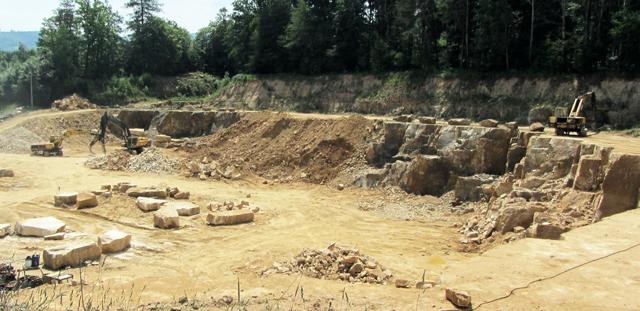DŁUGOPOLE – YELLOW AND GREY SANDSTONE

The popularity of the sandstone from Długopole began with the opening of a section of the railway route between Kłodzko and Międzylesie in 1875 – a section of the planned line from Wrocław to Austria.
On the one hand, this material was used in the construction of tunnels, viaducts, bridges and station buildings. On the other hand, the railway made it possible to transport this interesting stone outside the Kłodzko Land.

The modern history of mining begins around 2000, when the Piasmar company began to clean up the deposit after its previous owners. At present, mining is carried out using a traditional method, without the use of explosives, and crushing larger lumps is performed by wedging.
Technical parameters allow for practically unlimited possibilities of using the Długopole sandstone, both indoors and outdoors. It is easier to process than granite but much more difficult than other sandstones. Tools for granite are used for processing because tools for sandstone fail and stop working. It is also unsuitable for sharpening diamond tools.
Długopole has a light yellow colour, with streaks of yellow (presence of limonite) in the form of rings, the so-called Liesegang rings. The solids have a more intense yellow colouring of the rings near the edge of the solid and an increasingly lighter colour near its centre. This makes it possible to receive interesting effects by placing slabs obtained from the cutting of a single block next to each other. Recently, in the deposit there was also exposed a light-grey sandstone bed with darker streaks, structural disturbances in the form of so-called laminae.
The grains of the Długopole sandstone are fine, slightly rounded and bonded with a silica-quartzite binder. This makes the material very hard and its high abrasion resistance is a rarity among yellow sandstones – abrasion resistance on Bohme’s wheel tester is almost identical to that of the Strzegom granite. It is suitable for all applications where there is heavy traffic: public buildings, intensively used stairs, floors – everywhere it will show the same durability and resistance as granite.
The material is compact and non-porous – no glue can seep through even 12 mm thick tiles. These features allow the use of vacuum grippers for transporting the material. It also shows low water absorption, so it works well on plinths, because it will not soak up water from the substrate. When flamed it has anti-slip properties and can be used for making pools, floors and stairs. An important feature of Długopole is its minimal anisotropy (variation of parameters depending on the direction of processing). This enables the stone to be cut and worked without the need to pay special attention to its layering, as this has little effect on its properties.
Source: Kurier kamieniarski
Author: Paweł Szambelan | Published: 21.12.2020
